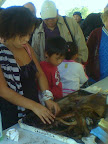USA Festival of Science and Engineering 2010—just a fraction of what was there
By Peggy Ashbrook
Posted on 2010-10-30
I had a good time at the USA Science and Engineering Festival Expo in Washington, D.C. on October 23 and 24. I was really impressed with the large number of people attending—great diversity of age, sex, ethnicity, race, language, families and individuals. I saw one of my neighbors there, a young mom with 3 kids and her mother—someone I didn’t realize was interested in science or engineering, and I saw a lot of STEM* geek t-shirts. Well attended, the festival was crowded even at 4:30 on Sunday just before closing.
*STEM is an acronym for Science, Technology, Engineering and Math.
The number of people in attendance made it difficult for young children to get access to some booths, but by going with the flow they could see some really cool stuff. Hopefully the cool stuff will inspire children to take science classes, join science clubs, and pursue science inquiry at home and in informal settings.
My favorite exhibits were:
Dissecting the Humboldt squid–we were there before the dissection but got to touch it and learn all the external anatomy–Squids for Kids.
Making a “Puff-mobile” using (at most) 3 straws, 4 lifesavers, a 9cm x 12cm piece of paper, 2 paper clips and 50 cm of tape and then racing it by blowing it (windpower)–The Society of Women Engineers.
The non-Newtonian fluid pool where kids ran across the cornstarch and water mixture (except for the child who stopped and sank to her ankles)–Michigan Technological University.
Meeting Johannes Kepler and George Washington Carver, and Sid the Science Kid.
Other engaging booths:
The stink bug and cricket CO2 output measuring activity at NSTA was cool for preteens and up.
NASA’s 3-D Mars landscape, puzzles of the Earth, and telescope viewings of the Sun.
A giant Newton’s cradle made with volleyballs.
Ancient ice from the Arctic, sea ice, glacier ice, and permafrost ice, .
“Maggot Monet” creating art by letting flesh eating fly larvae crawl through paint drops, putting them back on the paper with forceps when they wander too far.
What did you see?
Peggy
Disclaimer: The views expressed in this blog post are those of the author(s) and do not necessarily reflect the official position of the National Science Teaching Association (NSTA).




